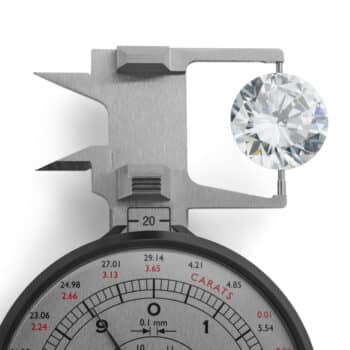As “GIA certified Jewelry Professionals”, we dedicate our experience to deliver you all the Knowledge needed when it comes to Gold & Diamond. We honor the trust you put in us, thus, we are more than happy to guide you and assist you with any inquiry or concern.

Carat
The term carat is often misunderstood. It refers to diamond’s weight, not its size. All else being equal, diamond price increases with carat weight, because larger diamonds are more often desirable. But two diamonds of equal carat weight can have very different values (and prices) depending on three other factors within the 4Cs.
Selecting a carat weight slightly below the whole and half-carat marks makes a huge difference. For example, instead of 1.00 carat diamond, consider a 0.90 carat weight. This will save a considerable amount of money, and the slight difference will never be noticed.

Clarity
Diamond clarity is the assessment of small imperfections on the surface and within the stone. Evaluating Diamond Clarity involves determining the number, size, nature & position of these characteristics, as well as how these affect the overall appearance of the stone. To naked Eye, a VS1 and an SI2 diamond may look exactly the same, but these diamonds are quite different in terms of overall quality. This is why expert and accurate assessment of clarity is extremally important.
Clarity Scale:
Flawless
Internally Flawless
Very Very Slightly Included: VVS1-VVS2
Very Slightly Included: VS1-VS2
Slightly Included:SI1-SI
Included: I1-I2-I3

Color
The color evaluation of most gem-quality diamond is based on the absence of color. Many of these color distinctions are so subtle that they are invisible to the untrained eye; however, these distinctions make a very big difference in diamond quality and price. The GIA Color Grading Scale is the most widely accepted grading system:
Color Scale:
Colorless diamonds: D-F
Near-colorless diamonds: G-J
Faint: K-M
Very light: N-R
Light: S-Z

Cut
The most underrated C of the 4Cs yet with equal importance and impact on value. The quality of cut is crucial to the diamond’s final beauty and value. Have you ever noticed how many surfaces a diamond has? A diamond’s cut refers to how well-proportioned the dimensions of a diamond are, and how these surfaces, or facets, are positioned to create sparkle and brilliance. For example, what is the ratio of the diamond’s diameter in comparison to its depth? These small, yet essential, factors determine the diamond’s beauty and price.
Cut Scale:
Excellent
Very Good
Good
Fair
Poor
The fifth C: “Confidence”
Maybe the most important “C” of them all, the one related to confidence and trust. When it comes to owning a valuable piece of Jewelry, you need to have deep confidence and trust in the party your are dealing with. All details must be clarified. Trust is a key element that we personally take very seriously; Thus you will find us always available to guide and enlighten you on all the industry’s secrets.